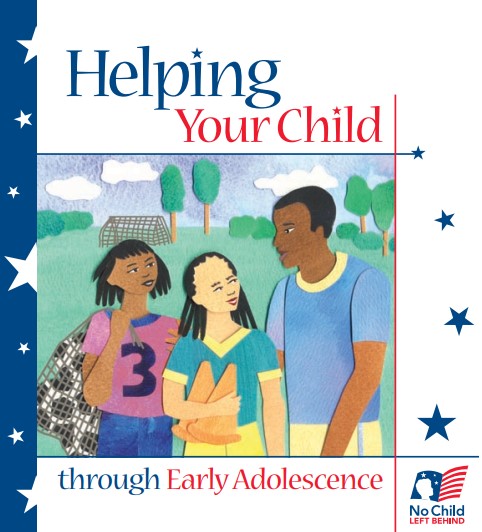Helping Your Child through Early Adolescence

Helping Your Child through Early Adolescence
For Parents of Children From 10 Through 14
Early adolescence can be a challenging time for children and parents alike. Parents often feel unprepared, and they may view the years from 10 through 14 as a time just “to get through.”
However, research and common sense tell us that this view is very limited. During the early adolescent years, parents and families can greatly influence the growth and development of their children. We sell our children short if we expect little from them and we sell ourselves short if we believe that we have no influence.
A growing awareness that young adolescents can accomplish a great dealis behind a national effort to improve education in America’s middle grades. At the heart of the No Child Left Behind Act of 2001 is a promise to raise standards for all children and to help all children meet those standards.
In support of this goal, President George W. Bush is committed to promoting the very best teaching programs. Well-trained teachers and instruction that is based on research can bring the best teaching approaches and programs to children of all ages and help ensure that no child is left behind.
Helping Your Child through Early Adolescence is part of the president’s efforts to provide parents with the latest research and practical information that can help you support your children both at home and in school.
It’s not easy to raise a young teen. Many outside influences distract our children and complicate our efforts. Exhaustion, anxiety, a lack of support and limited resources may make it hard for us to be all that we want to be for our children. But whatever the challenges, we share one aim: to do the best job possible as parents. We hope that you will find this booklet helpful in achieving this goal.
Learning as much as you can about the world of early adolescents is an important step toward helping your child—and you—through the fascinating, confusing and wonderful years from ages 10 through 14.
Bumps, No Boulders
Mention being the parent of a young adolescent and other adults may roll their eyes and express their sympathy. They see images of bedrooms in which lost homework assignments share floor space with potato chip wrappers and grubby sweatpants.
But parents’ concerns run deeper than messy bedrooms. They worry about the problems that young adolescents often face rocky emotions, rebellion, peer pressures, low motivation, drugs, alcohol and pregnancies.
During the years from ages 10 through 14, children undergo many physical, emotional and mental changes. Together these changes can throw the lives of young teens and their parents off-balance. Major problems may arise, particularly among children who are already at risk of school failure.
On the other hand, if you talk to adults who work with young adolescent’s—teachers, school counselors and principals—you see another view of these children. It’s true that young teens can be frustrating and challenging and that they can test their parents’ patience.
It’s also true, however, that these same youngsters can be funny, curious, imaginative and eager to learn. As research confirms, most young teens run into bumps but no boulders. They (and their parents) hit some rough spots, but they get through the young adolescent years successfully and grow into adults who find work, create meaningful relationships and become good citizens.
The journey through these years is easier when parents, families and caregivers learn as much as they can about this time in children’s lives and when they give their children support. This booklet is designed to help in this effort.
It pulls together information from scientifically-based research, as well as from interviews with award-winning middle school teachers, counselors and principals—most of whom also are—or have been recently—parents of young adolescents.
The booklet addresses the following questions and concerns that parents of young teens often raise:
★ How will my child change between the ages of 10 and 14?
★ What can I do to be a good parent for my adolescent?
★ How can I communicate better with my child?
★ How much independence should I give my child?
★ How can I help my child to become more confident?
★ How can I help my child to form good friendships and to resist harmful peer pressure?
★ What can I do to keep the media from being a bad influence
on my child?
★ What is school like for adolescents?
★ What’s the best way for me to stay involved in my child’s school and in other activities?
★ How can I help my child to be a successful reader?
★ How can I keep my child motivated to learn and do well, both in and out of school?
★ What can I do to help my child to develop good values and to learn right from wrong?
★ How can I tell—and what can I do—if my child is having a serious problem?
The journey through these years is easier when parents, families and caregivers learn as much as they can about this time in children’s lives and when they give their children support.
How will my child change between the ages of 10 and 14?
Throughout our lives we grow and change, but during early adolescence the rate of change is especially evident. We consider 10-year-olds to be children; we think of 14-year-olds as “almost adults.” We welcome the changes, but we also find them a little disturbing. When children are younger, it is easier to predict when a change might take place and how rapidly.
But by early adolescence, the relationship between a child’s real age and her* developmental milestones grows weaker. Just how young teens develop can be influenced by many things: for example, genes, families, friends, neighborhoods and values and other forces in society.
Physical Changes
As they enter puberty, young teens undergo a great many physical changes, not only in size and shape, but in such things as the growth of pubic and underarm hair and increased body odor. For girls, changes include the development of breasts and the start of menstruation, for boys, the development of testes.
Adolescents do not all begin puberty at the same age. For girls, it may take place anywhere from the age of 8 to 13; in boys, on average, it happens about two years later. This is the time period when students’ physical characteristics vary the most within their classes and among their friends—some may grow so much that, by the end of the school year, they may be too large for the desks they were assigned in September. Others may change more slowly.
READ MUCH MORE INSIDE…
“HELPING YOUR CHILD THROUGH EARLY ADOLESENCE”

Click on the Blue Button Below for Instant Access!
Our 100% Money Back Guarantee:

If for any reason you decided within 30 days that “HELPING YOUR CHILD THROUGH EARLY ADOLESENCE” isn’t for you, simply notify us by email and we’ll gladly refund your money – no questions asked. That’s our Ironclad Guarantee!
Your name and email will Never be shared, sold, or given to anyone.
We keep our subscriber’s privacy sacred. We do not sell or rent your personal information to other parties. What’s more you can always unsubscribe at any time!
Regards, Coyalita
Behavioral Health Rehabilitative Specialist & Addiction Counselor
Copyright © 2021-2024 Thresholdlivecoyalita.com All Rights Reserved Privacy Policy – Earnings Disclaimer – Terms of Use – Contact Us




